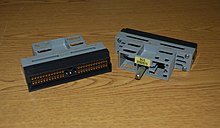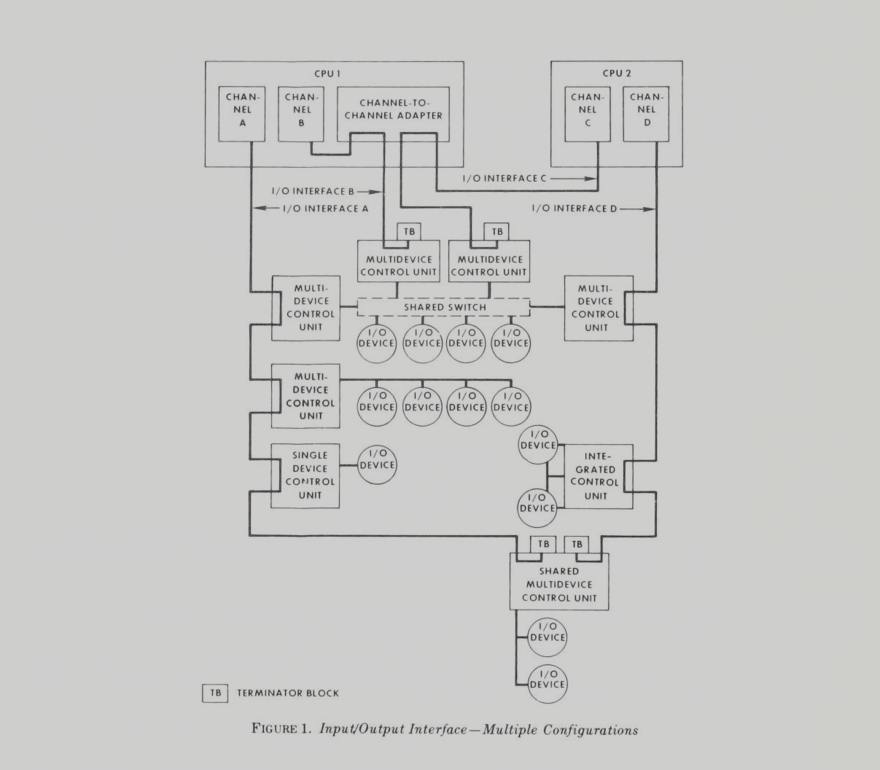
Bus and Tag is an "IBM standard for a computer peripheral interface", and was commonly used to connect their mainframe computers to peripheral devices such as line printers, disk storage, magnetic tape drives and IBM 3270 display controllers. The technology uses two sets of thick, multi-connector copper cables, one set, carrying data, called the bus, and the other set, carrying control information, called the tag.

Bus and Tag cables are "daisy chained"; and one interface can attach up to eight peripheral control units. The last control unit in the chain must have a terminator plug. Each control unit can attach a maximum number of devices, "sixteen is a typical number." There is an architectural limit of 256 devices per channel, and initially a limitation of 200 feet (61 m), later extended to 400 feet (120 m), between the mainframe and the control unit. Bus and Tag channels handle data rates up to 4.5 MB per second. Only one device can transfer data at a time.
Bus and Tag architecture was also used by other computer manufacturers to attach IBM peripherals to their systems. It was later published by the US National Technical Information Service (NTIS) as FIPS PUB 60-2, I/O Channel Interface.
Bus and Tag was introduced with System/360 in 1964, and was also used with System/370. With the introduction of serial, fiber optic ESCON in the 1990s Bus and Tag channels were re-christened "parallel channels", and were gradually superseded. "Parallel channels are not available on the newest mainframes and are slowly being displaced on older systems." Equipment is available to allow connection of older devices using Bus and Tag to mainframe FICON or ESCON channels.
Evolution
Originally the System/360 had two types of channel; the byte multiplexor channel and the selector channel. Since that time there have been several extension to the channel architecture.
In 1970, IBM announced the 2880 block multiplexor channel for the 360/85 and 360/195, in support of the IBM 2305 fixed head disk. This channel supports disconnected command chaining, which allows a high speed device to free the channel when performing a requested operation, without terminating the channel program. This channel also has an optional two-byte interface feature (bus extension feature), which allows a second bus cable in order to operate at 3.0 MB/S. In the same year, IBM announced the System/370, which included block multiplexor channels.
As DASD became faster, the original channel protocols could not support the required transfer rates and the two-byte interface was too expensive. As a solution, IBM offered data streaming initially supporting 3.0 MB/s and eventually supporting 4.5 MB/s.
Example
The following schematic shows a complex system with two CPUs and multiple peripherals connected using bus and tag cabling.

Notes
- Three for a channel with the Two-byte Interface feature.
- Two for a channel with the Interface feature.
References
- IBM Corporation. "IBM Terminology "O"". IBM Globalization. Retrieved Sep 8, 2018.
- IBM System/360 and System/370 I/O Interface Channel to Control Unit Original Equipment Manufacturers' Information (PDF) (Fifth ed.), IBM, January 1978, GA22-6974-4
- PC Magazine. "Definition of: bus and tag channel". Encyclopedia. Retrieved Sep 8, 2011.
- ^ IBM Corporation. "Mainframe hardware: Evolving design". IBM® IBM Knowledge Center. Retrieved Sep 8, 2018.
- ^ Dickens, Steven. "Evolution of z Systems Channel – A Parallel Universe". MAINFRAME DEBATE. Retrieved Sep 8, 2018.
- PC Magazine. "Definition of: parallel channel". Encyclopedia. Retrieved Sep 8, 2018.
- I/O Channel Interface (PDF) (Report). National Technical Information Service. July 29, 1983. FIPS PUB 60-2. Retrieved May 18, 2023.
- IBM International Technical Support Organization (April 2018). IBM Z Connectivity Handbook (PDF). p. 193. ISBN 978-0738443089. Retrieved Sep 8, 2018.
- "1970". DPD Chronology. IBM. 23 January 2003. p. 4.
On February 10, DPD introduces two products: the IBM 2880 block multiplexer channel and IBM 2305 fixed head storage facility, designed for IBM System/360 Models 85 and 195.
- OEMI, p. 3-1, Bus Extension Feature.
- OEMI, pp. 3-3–3-6, Data-Streaming Feature.
External links
- OEMI
- IBM System/360 and System/370 I/O Interface Channel to Control Unit Original Equipment Manufacturers' Information (PDF) (Tenth ed.). IBM Corporation. February 1988. GA22-6974-4. Retrieved Sep 8, 2018.